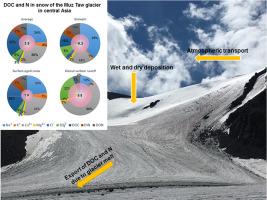当前位置:
X-MOL 学术
›
Sci. Total Environ.
›
论文详情
Our official English website, www.x-mol.net, welcomes your
feedback! (Note: you will need to create a separate account there.)
Characterization, sources and transport of dissolved organic carbon and nitrogen from a glacier in the Central Asia.
Science of the Total Environment ( IF 8.2 ) Pub Date : 2020-04-03 , DOI: 10.1016/j.scitotenv.2020.138346 Tanguang Gao 1 , Shichang Kang 2 , Yulan Zhang 3 , Michael Sprenger 4 , Feiteng Wang 5 , Wentao Du 5 , Xiaoming Wang 5 , Xiaoxiang Wang 5
Science of the Total Environment ( IF 8.2 ) Pub Date : 2020-04-03 , DOI: 10.1016/j.scitotenv.2020.138346 Tanguang Gao 1 , Shichang Kang 2 , Yulan Zhang 3 , Michael Sprenger 4 , Feiteng Wang 5 , Wentao Du 5 , Xiaoming Wang 5 , Xiaoxiang Wang 5
Affiliation

|
Glacier melting represents an important flux of carbon and nitrogen (N) and affects the hydrological cycle. In this study, we presented the features of dissolved organic carbon (DOC) and N concentrations, their potential sources and export from the Muz Taw glacier in Central Asia. The average DOC and total dissolved nitrogen concentrations were 1.12 ± 1.66 and 0.62 ± 0.59 mg L-1 in surface snow and 0.21 ± 0.04 and 0.31 ± 0.10 mg L-1 in snowpit samples, respectively. The values from snowpit of the Muz Taw glacier were comparable to data reported from glaciers in the Tibetan Plateau but were considerably higher than those from polar regions. The C/N ratios in snow ranged from 0.7 to 11.7, indicating the high bioavailability of DOC. Mass absorption cross section of DOC at 365 nm in snow indicated that during the snow melting process, light-absorbing DOC was prone to be attached to particles, especially in the ablation zone of the Muz Taw glacier. Radiative forcing caused by DOC contributed approximately 38 ± 26% and 18 ± 9.8% of that caused by black carbon for surface snow and snowpit samples, respectively. DOC and N deposition on the glacier surface were influenced by the combined sources from anthropogenic input, wild biomass burning emission, and dust input from local regions and long range transport. Export of DOC and N from the Muz Taw glacier was estimated to be 3.47-18.5 t C yr-1 and 5.11-10.23 t N yr-1 respectively, based on their concentrations and current glacier mass balance. These results enhanced our understanding of the sources and cycle of DOC and N released from glaciers in Central Asia, where glacier meltwater can protect the population from drought stress.
中文翻译:

来自中亚冰川的溶解有机碳和氮的特征,来源和运输。
冰川融化代表碳和氮(N)的重要通量,并影响水文循环。在这项研究中,我们介绍了中亚Muz Taw冰川中溶解有机碳(DOC)和N浓度的特征,其潜在来源和出口。表层积雪的平均DOC和总溶解氮浓度分别为1.12±1.66和0.62±0.59 mg L-1,雪场样品的分别为0.21±0.04和0.31±0.10 mg L-1。Muz Taw冰川雪坑的值与青藏高原冰川的数据可比,但远高于极地地区。雪中的C / N比在0.7到11.7之间,表明DOC具有很高的生物利用度。雪中DOC在365 nm处的质量吸收截面表明,在融雪过程中,吸收光的DOC容易附着在颗粒上,特别是在Muz Taw冰川的消融区。DOC引起的辐射强迫分别贡献了地表雪和雪坑样本中黑碳引起的辐射强迫的38±26%和18±9.8%。冰川表面的DOC和N沉积受到人为输入,野生生物量燃烧排放,局部地区粉尘输入和远距离迁移的综合影响。根据其浓度和当前冰川的质量平衡,估计穆兹陶德冰川的DOC和N出口分别为3.47-18.5 t C yr-1和5.11-10.23 t N yr-1。这些结果加深了我们对中亚冰川释放的DOC和N的来源和周期的了解,那里的冰川融水可以保护人们免受干旱胁迫。
更新日期:2020-04-06
中文翻译:

来自中亚冰川的溶解有机碳和氮的特征,来源和运输。
冰川融化代表碳和氮(N)的重要通量,并影响水文循环。在这项研究中,我们介绍了中亚Muz Taw冰川中溶解有机碳(DOC)和N浓度的特征,其潜在来源和出口。表层积雪的平均DOC和总溶解氮浓度分别为1.12±1.66和0.62±0.59 mg L-1,雪场样品的分别为0.21±0.04和0.31±0.10 mg L-1。Muz Taw冰川雪坑的值与青藏高原冰川的数据可比,但远高于极地地区。雪中的C / N比在0.7到11.7之间,表明DOC具有很高的生物利用度。雪中DOC在365 nm处的质量吸收截面表明,在融雪过程中,吸收光的DOC容易附着在颗粒上,特别是在Muz Taw冰川的消融区。DOC引起的辐射强迫分别贡献了地表雪和雪坑样本中黑碳引起的辐射强迫的38±26%和18±9.8%。冰川表面的DOC和N沉积受到人为输入,野生生物量燃烧排放,局部地区粉尘输入和远距离迁移的综合影响。根据其浓度和当前冰川的质量平衡,估计穆兹陶德冰川的DOC和N出口分别为3.47-18.5 t C yr-1和5.11-10.23 t N yr-1。这些结果加深了我们对中亚冰川释放的DOC和N的来源和周期的了解,那里的冰川融水可以保护人们免受干旱胁迫。











































 京公网安备 11010802027423号
京公网安备 11010802027423号